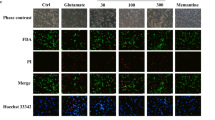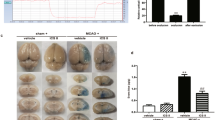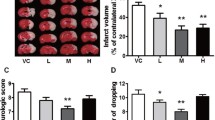Abstract
The main pathological features of ischemic stroke include neuronal damage and blood–brain barrier (BBB) dysfunction. Previous studies have shown that Evans Blue, a dye used to probe BBB integrity, could enter the brain only during the pathological status of ischemic stroke, indicating the potential pathologically activated therapeutic use of this chemical to treat ischemic stroke. In this study, we have reported that Evans Blue could produce in vitro neuroprotective effects against iodoacetic acid (IAA)-induced hypoxia neuronal death in HT22 cells. We further found that P2X purinoreceptor 4 (P2X4R), a subtype of ATP-gated cation channel, was expressed in HT22 cells. Evans Blue could prevent IAA-induced increase of P2X4R mRNA and protein expression. Interestingly, shRNA of P2X4R could protect against IAA-induced activation of p38, and SB203580, a specific inhibitor of p38, could reverse IAA-induced neurotoxicity, indicating that p38 is a downstream signaling molecule of P2X4R. Molecular docking analysis further demonstrated the possible interaction between Evans Blue and the ATP binding site of P2X4R. Most importantly, pre-treatment of Evans Blue could largely reduce neurological and behavioral abnormity, and decrease brain infarct volume in middle cerebral artery occlusion/reperfusion (MCAO) rats. All these results strongly suggested that Evans Blue could exert neuroprotective effects via inhibiting the P2X4R/p38 pathway, possibly by acting on the ATP binding site of P2X4R, indicating that Evans Blue might be further developed as a pathologically activated therapeutic drug against ischemic stroke.







Similar content being viewed by others
References
Asatryan L, Ostrovskaya O, Lieu D, Davies DL (2018) Ethanol differentially modulates P2X4 and P2X7 receptor activity and function in BV2 microglial cells. Neuropharmacology 128:11–21. https://doi.org/10.1016/j.neuropharm.2017.09.030
Caliceti P, Veronese FM (2003) Pharmacokinetic and biodistribution properties of poly(ethylene glycol)-protein conjugates. Adv Drug Deliv Rev 55:1261–1277. https://doi.org/10.1016/s0169-409x(03)00108-x
Chen YF, Wu KJ, Wood WG (2013) Paeonia lactiflora extract attenuating cerebral ischemia and arterial intimal hyperplasia is mediated by paeoniflorin via modulation of VSMC migration and Ras/MEK/ERK signaling pathway. Evid Based Complement Alternat Med 2013:482428. https://doi.org/10.1155/2013/482428
Cui W et al (2013) The anti-cancer agent SU4312 unexpectedly protects against MPP plus -induced neurotoxicity via selective and direct inhibition of neuronal NOS. Br J Pharmacol 168:1201–1214. https://doi.org/10.1111/bph.12004
De Man JG, De Winter BY, Seerden TC, De Schepper HU, Herman AG, Pelckmans PA (2003) Functional evidence that ATP or a related purine is an inhibitory NANC neurotransmitter in the mouse jejunum: study on the identity of P2X and P2Y purinoceptors involved. Br J Pharmacol 140:1108–1116. https://doi.org/10.1038/sj.bjp.0705536
Donnan GA, Fisher M, Macleod M, Davis SM (2008) Stroke. Lancet 371:1612–1623. https://doi.org/10.1016/s0140-6736(08)60694-7
Fluri F, Schuhmann MK, Kleinschnitz C (2015) Animal models of ischemic stroke and their application in clinical research. Drug Des Dev Ther 9:3445–3454. https://doi.org/10.2147/Dddt.S56071
Fu YS et al (2015) Pretreatment with Evans blue, a stimulator of BK(Ca) channels, inhibits compound 48/80-induced shock, systemic inflammation, and mast cell degranulation in the rat. Histochem Cell Biol 144:237–247. https://doi.org/10.1007/s00418-015-1332-4
Gong QJ et al (2009) ATP induces long-term potentiation of C-fiber-evoked field potentials in spinal dorsal horn: the roles of P2X4 receptors and p38 MAPK in microglia. Glia 57:583–591. https://doi.org/10.1002/glia.20786
Guo T et al (2018) 1, 25–D3 protects from cerebral ischemia by maintaining bbb permeability via PPAR-gamma activation. Front Cell Neurosci 12:480. https://doi.org/10.3389/fncel.2018.00480
Hattori M, Gouaux E (2012) Molecular mechanism of ATP binding and ion channel activation in P2X receptors. Nature 485:207–212. https://doi.org/10.1038/nature11010
Howells DW et al (2010) Different strokes for different folks: the rich diversity of animal models of focal cerebral ischemia. J Cerebr Blood F Met 30:1412–1431. https://doi.org/10.1038/jcbfm.2010.66
Huang L, Otrokocsi L, Sperlagh B (2019) Role of P2 receptors in normal brain development and in neurodevelopmental psychiatric disorders. Brain Res Bull. https://doi.org/10.1016/j.brainresbull.2019.01.030
Irwin JA, Erisir A, Kwon I (2016) Oral triphenylmethane food dye analog, brilliant blue G, prevents neuronal loss in APPSwDI/NOS2-/- mouse model. Curr Alzheimer Res 13:663–677
Jacobson O, Kiesewetter DO, Chen X (2016) Albumin-binding Evans Blue derivatives for diagnostic imaging and production of long-acting therapeutics. Bioconjug Chem 27:2239–2247. https://doi.org/10.1021/acs.bioconjchem.6b00487
Jin X et al (2020) Inhibition of acetylcholinesterase activity and beta-amyloid oligomer formation by 6-bromotryptamine A, a multi-target anti-Alzheimer’s molecule. Oncol Lett 19:1593–1601. https://doi.org/10.3892/ol.2019.11226
Kawate T, Michel JC, Birdsong WT, Gouaux E (2009) Crystal structure of the ATP-gated P2X(4) ion channel in the closed state. Nature 460:592–598. https://doi.org/10.1038/nature081980
Khakh BS, North RA (2012) Neuromodulation by extracellular ATP and P2X receptors in the CNS. Neuron 76:51–69. https://doi.org/10.1016/j.neuron.2012.09.024
Kritis AA, Stamoula EG, Paniskaki KA, Vavilis TD (2015) Researching glutamate - induced cytotoxicity in different cell lines: a comparative/collective analysis/study. Front Cell Neurosci 9:91. https://doi.org/10.3389/fncel.2015.00091
Lapchak PA, Araujo DM (2007) Advances in ischemic stroke treatment: neuroprotective and combination therapies. Expert Opin Emerg Drugs 12:97–112. https://doi.org/10.1517/14728214.12.1.97
Lazarowski ER, Boucher RC, Harden TK (2003) Mechanisms of release of nucleotides and integration of their action as P2X- and P2Y-receptor activating molecules. Mol Pharmacol 64:785–795. https://doi.org/10.1124/mol.64.4.785
Lipton P (1999) Ischemic cell death in brain neurons. Physiol Rev 79:1431–1568. https://doi.org/10.1152/physrev.1999.79.4.1431
Lipton SA (2007) Pathologically activated therapeutics for neuroprotection. Nat Rev Neurosci 8:803
Liu J, Li L, Suo WZ (2009) HT22 hippocampal neuronal cell line possesses functional cholinergic properties. Life Sci 84:267–271. https://doi.org/10.1016/j.lfs.2008.12.008
Manaenko A, Chen H, Kammer J, Zhang JH, Tang JP (2011) Comparison Evans Blue injection routes: Intravenous versus intraperitoneal, for measurement of blood-brain barrier in a mice hemorrhage model. J Neurosci Meth 195:206–210. https://doi.org/10.1016/j.jneumeth.2010.12.013
Maria NP et al (2013) P2X4 subunits are part of P2X native channels in murine myenteric neurons. Eur J Pharmacol 709:93–102. https://doi.org/10.1016/j.ejphar.2013.03.045
Martins I et al (2009) Chemotherapy induces ATP release from tumor cells. Cell Cycle (Georgetown, Tex) 8:3723–3728. https://doi.org/10.4161/cc.8.22.10026
Neuhaus AA, Couch Y, Hadley G, Buchan AM (2017) Neuroprotection in stroke: the importance of collaboration and reproducibility. Brain 140:2079–2092. https://doi.org/10.1093/brain/awx126
Nito C, Kamada H, Endo H, Niizuma K, Myer DJ, Chan PH (2008) Role of the p38 mitogen-activated protein kinase/cytosolic phospholipase A2 signaling pathway in blood-brain barrier disruption after focal cerebral ischemia and reperfusion. J Cereb Blood Flow Metab 28:1686–1696. https://doi.org/10.1038/jcbfm.2008.60
Obermeier B, Daneman R, Ransohoff RM (2013) Development, maintenance and disruption of the blood-brain barrier. Nat Med 19:1584–1596. https://doi.org/10.1038/nm.3407
Osgood MJ et al (2016) Use of Brilliant Blue FCF during vein graft preparation inhibits intimal hyperplasia. J Vasc Surg 64:471–478. https://doi.org/10.1016/j.jvs.2015.02.028
Reiner PB, Laycock AG, Doll CJ (1990) A pharmacological model of ischemia in the hippocampal slice. Neurosci Lett 119:175–178. https://doi.org/10.1016/0304-3940(90)90827-v
Samways DS, Li Z, Egan TM (2014) Principles and properties of ion flow in P2X receptors. Front Cell Neurosci 8:6. https://doi.org/10.3389/fncel.2014.00006
Simoes Pires EN, Frozza RL, Hoppe JB, Menezes Bde M, Salbego CG (2014) Berberine was neuroprotective against an in vitro model of brain ischemia: survival and apoptosis pathways involved. Brain Res 1557:26–33. https://doi.org/10.1016/j.brainres.2014.02.021
Song JH, Shin MS, Hwang GS, Oh ST, Hwang JJ, Kang KS (2018) Chebulinic acid attenuates glutamate-induced HT22 cell death by inhibiting oxidative stress, calcium influx and MAPKs phosphorylation. Bioorg Med Chem Lett 28:249–253. https://doi.org/10.1016/j.bmcl.2017.12.062
Sperling O, Bromberg Y, Oelsner H, Zoref-Shani E (2003) Reactive oxygen species play an important role in iodoacetate-induced neurotoxicity in primary rat neuronal cultures and in differentiated PC12 cells. Neurosci Lett 351:137–140. https://doi.org/10.1016/s0304-3940(03)00858-9
Strassburger M, Braun H, Reymann KG (2008) Anti-inflammatory treatment with the p38 mitogen-activated protein kinase inhibitor SB239063 is neuroprotective, decreases the number of activated microglia and facilitates neurogenesis in oxygen-glucose-deprived hippocampal slice cultures. Eur J Pharmacol 592:55–61. https://doi.org/10.1016/j.ejphar.2008.06.099
Suna H, Arai M, Tsubotani Y, Hayashi A, Setiawan A, Kobayashi M (2009) Dysideamine, a new sesquiterpene aminoquinone, protects hippocampal neuronal cells against iodoacetic acid-induced cell death. Bioorg Med Chem 17:3968–3972. https://doi.org/10.1016/j.bmc.2009.04.025
Taylor BM, Fleming WE, Benjamin CW, Wu Y, Mathews WR, Sun FF (1996) The mechanism of cytoprotective action of lazaroids I: Inhibition of reactive oxygen species formation and lethal cell injury during periods of energy depletion. J Pharmacol Exp Ther 276:1224–1231
Ulmann L, Levavasseur F, Avignone E, Peyroutou R, Hirbec H, Audinat E, Rassendren F (2013) Involvement of P2X4 receptors in hippocampal microglial activation after status epilepticus. Glia 61:1306–1319. https://doi.org/10.1002/glia.22516
Varma R et al (2009) Amyloid-beta induces a caspase-mediated cleavage of P2X4 to promote purinotoxicity. Neuromol Med 11:63–75. https://doi.org/10.1007/s12017-009-8073-2
Vazquez-Villoldo N, Domercq M, Martin A, Llop J, Gomez-Vallejo V, Matute C (2014) P2X4 receptors control the fate and survival of activated microglia. Glia 62:171–184. https://doi.org/10.1002/glia.22596
Walchli T et al (2015) Quantitative assessment of angiogenesis, perfused blood vessels and endothelial tip cells in the postnatal mouse brain. Nat Protoc 10:53–74. https://doi.org/10.1038/nprot.2015.002
Yang R et al (2019) Quercetin relieved diabetic neuropathic pain by inhibiting upregulated P2X4 receptor in dorsal root ganglia. J Cell Physiol 234:2756–2764. https://doi.org/10.1002/jcp.27091
Yao L, Xue X, Yu P, Ni Y, Chen F (2018) Evans Blue dye: a revisit of its applications in biomedicine contrast media. Mol Imaging 2018:7628037. https://doi.org/10.1155/2018/7628037
Zhang QY et al (2017) Novel therapeutic effects of leonurine on ischemic stroke: new mechanisms of BBB integrity. Oxid Med Cell Longev 2017:7150376. https://doi.org/10.1155/2017/7150376
Zhou TT, Wu JR, Chen ZY, Liu ZX, Miao B (2014) Effects of dexmedetomidine on P2X4Rs, p38-MAPK and BDNF in spinal microglia in rats with spared nerve injury. Brain Res 1568:21–30. https://doi.org/10.1016/j.brainres.2014.04.025
Zhou X et al (2015) Protective effect of edaravone in primary cerebellar granule neurons against iodoacetic acid-induced cell injury. Oxid Med Cell Longev. https://doi.org/10.1155/2015/606981
Acknowledgements
This research was funded by the National Natural Science Foundation of China (81870853), Ningbo Sci & Tech Project for Common Wealth (2017C50042), Zhejiang Key Laboratory of Pathophysiology (201804), Open Project Program of State Key Laboratory of Food Nutrition and Safety, Tianjin University of Science & Technology (SKLFNS-KF-201806), Ningbo municipal innovation team of life science and health (2015C110026), LiDakSum Marine Biopharmaceutical Development Fund, and the K. C. Wong Magna Fund in Ningbo University.
Author information
Authors and Affiliations
Contributions
MXY and WC conceived the study design. MXY, YF, SCY, ZYW, XX, JCS, and SZY contributed to generation of research data. MXY, WC, and FFL helped to draft and revise the manuscript. All authors read and approved the final manuscript.
Corresponding author
Ethics declarations
Conflict of interest
The authors declare there is no financial conflict of interest.
Additional information
Publisher’s Note
Springer Nature remains neutral with regard to jurisdictional claims in published maps and institutional affiliations.
Rights and permissions
About this article
Cite this article
Yang, M., Feng, Y., Yan, S. et al. Evans Blue Might Produce Pathologically Activated Neuroprotective Effects via the Inhibition of the P2X4R/p38 Signaling Pathway. Cell Mol Neurobiol 41, 293–307 (2021). https://doi.org/10.1007/s10571-020-00852-z
Received:
Accepted:
Published:
Issue Date:
DOI: https://doi.org/10.1007/s10571-020-00852-z




